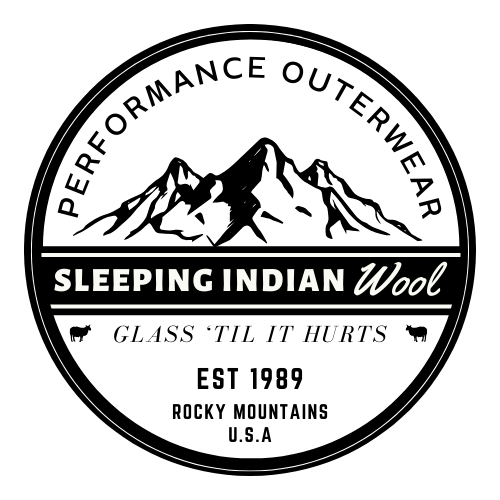Wool is the original High Tech fabric!
Many of today’s outerwear companies are saying their poly-this or micro-that garments are more waterproof, windproof, but often at the cost of breathability. Dumb plastic fibers trap heat and sweat and odor, age poorly, and are often loud when using them.
With synthetics, we often wound up wet from the inside from sweat, even in cold weather, and that is cause for serious trouble.
People have used wool for a thousand years. Today, a new generation of hunters are learning how versatile this fiber can be. Wool can be spun and woven into a lightweight cloth, heavy fabric or something in between.
Our wool is an excellent insulator yet is also water-resistant. Even when wet, our wool works to keep you warm.
Whether you’re navigating through dense conifer forests, slipping quietly through oak brush on a crisp winter morning, or waiting on-stand during an all-day drizzle, Sleeping Indian will keep you warm in cold weather while our woven wool provides the ultimate in silence.
How Does Wool Compare?
- Wool breathes better. Synthetic outer layers and cotton pull heat from you when they become wet, feeling cold even when it’s not. If it’s cold and you’re exerting yourself, sweat condenses on the inside of the shell… this is not good.
None of these problems exist with wool – snow, wet brush, light rain, drippy woods, sleet...
- Wool manages odors very well.
Lanolin is present in wool and is a natural anti-bacterial fatty substance, used in ointments, cosmetics, waterproof coatings etc.
- Wool does not catch light; it’s soft, natural fuzzy texture blends in.
The uneven surface, the scales of wool fiber prevent wool fabric from reflecting light well. Because wool accepts dye readily, you can have any pattern you want.
Our wool and dyes are UV neutral. Think of a deer – it’s not wearing a real camo pattern, but tends to be invisible unless moving or silhouetted. This is similar to wool.
-
Wool can provide a huge advantage to those who work with electricity, or in situations where static electricity can be a problem. Even embers popping off a campfire will melt right thru the synthetics, and wool stands up better and is far more difficult to burn. Wool is not fireproof, but it is more burn-resistant than many common synthetics, and far more resistant than human skin.
- Wool is quiet. The soft, spongy nature of wool works very well to stay stealthy in the backcountry

